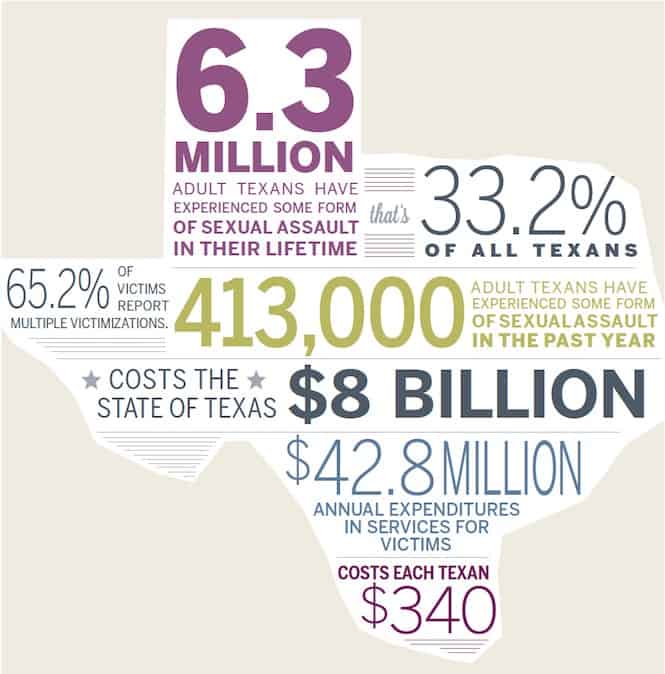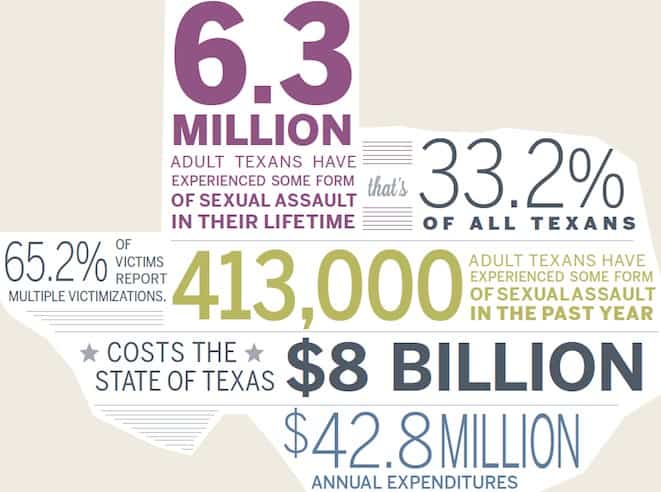Sexual assault is more pervasive in Texas now than in 2003, the time of the last statewide survey, according to a new study by the Institute on Domestic Violence & Sexual Assault (IDVSA) at The University of Texas at Austin School of Social Work. Download the report (pdf).
 The new survey reflects recent changes in the Texas Penal Code’s definition of sexual assault. The 2003 survey asked five questions related to unwanted vaginal, anal, or oral sex. To meet the expanded definition of the 2014 Texas Penal Code, this new survey added 10 questions to the five asked in 2003, covering other forms of sexual assault such as unwanted participation in sexual photos or movies, unwanted exposition of body parts, and unwanted sexual experiences while intoxicated and unable to consent.
The new survey reflects recent changes in the Texas Penal Code’s definition of sexual assault. The 2003 survey asked five questions related to unwanted vaginal, anal, or oral sex. To meet the expanded definition of the 2014 Texas Penal Code, this new survey added 10 questions to the five asked in 2003, covering other forms of sexual assault such as unwanted participation in sexual photos or movies, unwanted exposition of body parts, and unwanted sexual experiences while intoxicated and unable to consent.
When comparing responses to the five questions repeated from the 2003 study, results indicate an increase in lifetime sexual assault victimization among adult Texans from 13 percent in 2003 to 18 percent in 2015.
Overall, when using the new, expanded definition of sexual assault, results indicate that 32 percent of all Texans, or 6.3 million of adult Texans, have experienced some form of sexual assault during their lives.
“Our science today more accurately measures sexual assault crimes while an increase in public awareness over the past decade may mean that people think differently about their own victimization,” said social work professor Noël Busch-Armendariz, lead investigator and IDVSA director. “It is clear that we must continue to propel sexual assault onto our state agenda. Our responses should be swift, strategic and systematic, with targets from prevention to accountability. This crime makes an impact on our family members, co-workers, friends and students that attend our schools — those whom we describe in this study are all Texans.”
The survey also found that 2 in 5 women and 1 in 5 men have experienced some form of sexual assault. Whereas women are primarily sexually assaulted by men, men have an almost equal chance of being assaulted by either a woman or a man. The highest prevalence rate of sexual assault for women occurs in the 18 and older age group. In contrast, men report higher sexual assault prevalence for ages 17 and younger.
“It’s alarming that the prevalence of sexual assault has grown significantly since 2003. As a state it’s imperative that we devote adequate resources to preventing sexual violence and serving survivor needs. To do otherwise seems both reckless and heartless,” said Annette Burrhus-Clay, executive director of the Texas Association Against Sexual Assault.
The statewide survey used a representative sample of 1,203 adult Texans, drawn randomly from landline and mobile phones. Download the report (pdf).
By Andrea Campetella. Posted September 15, 2015.


